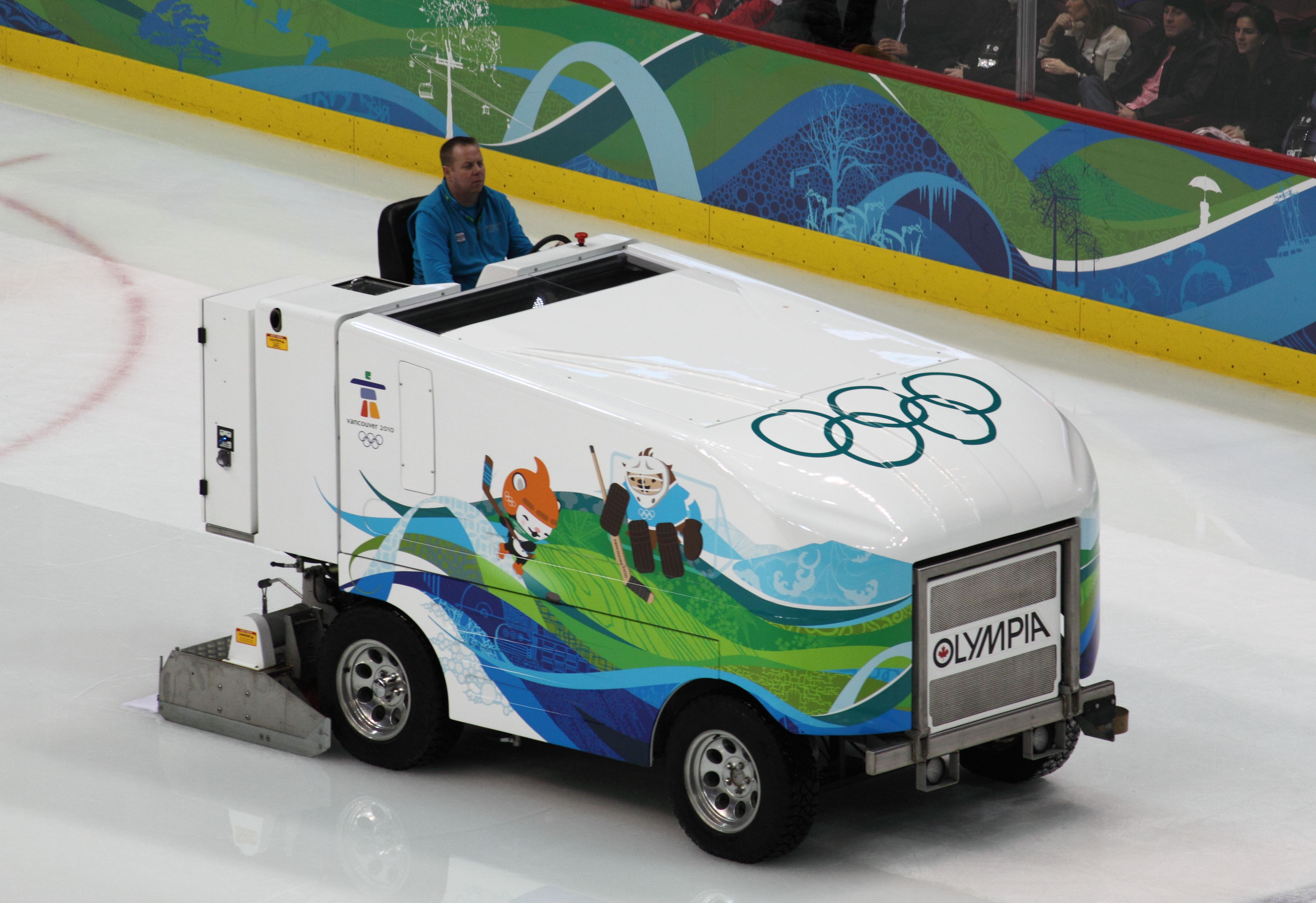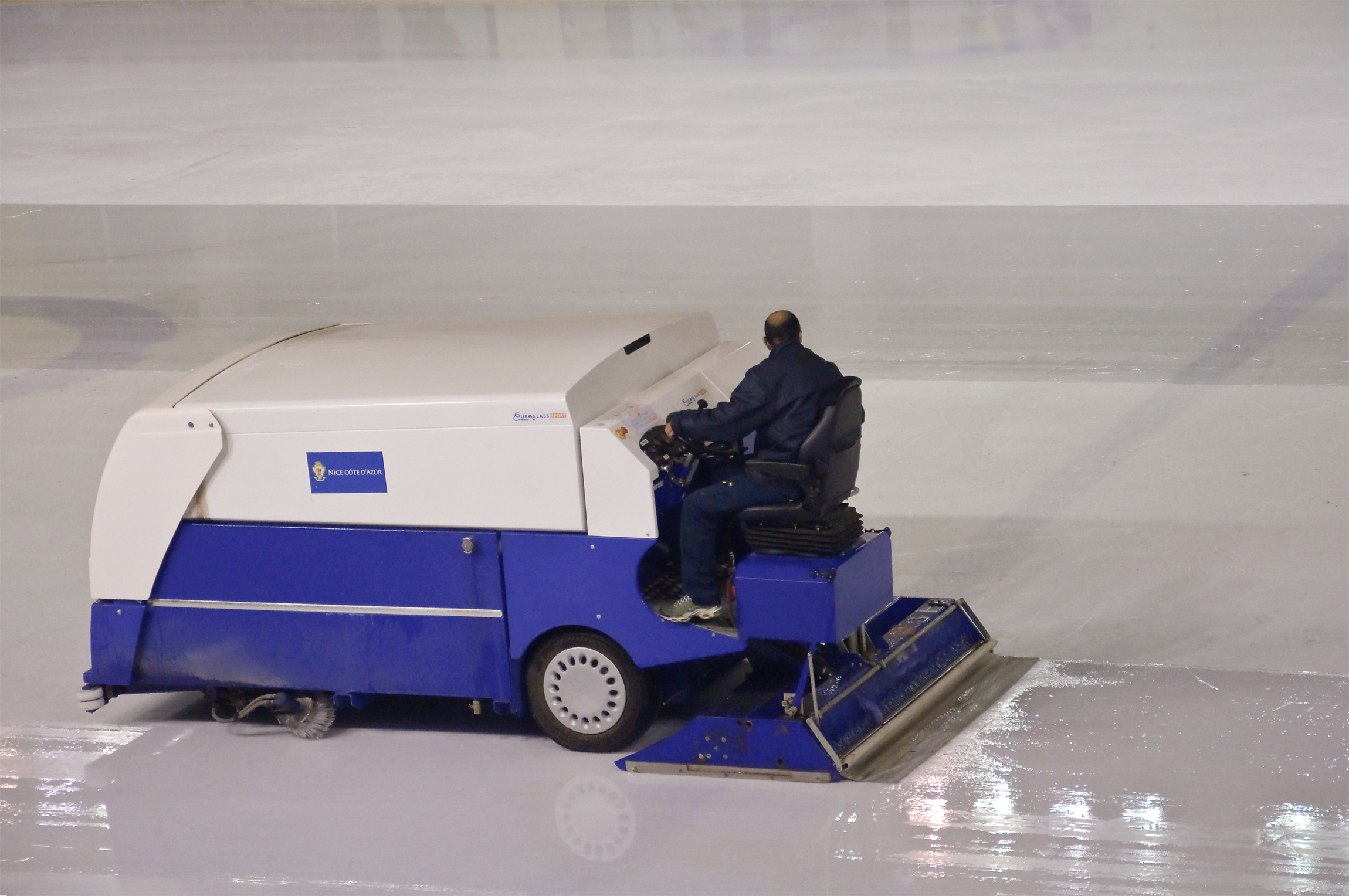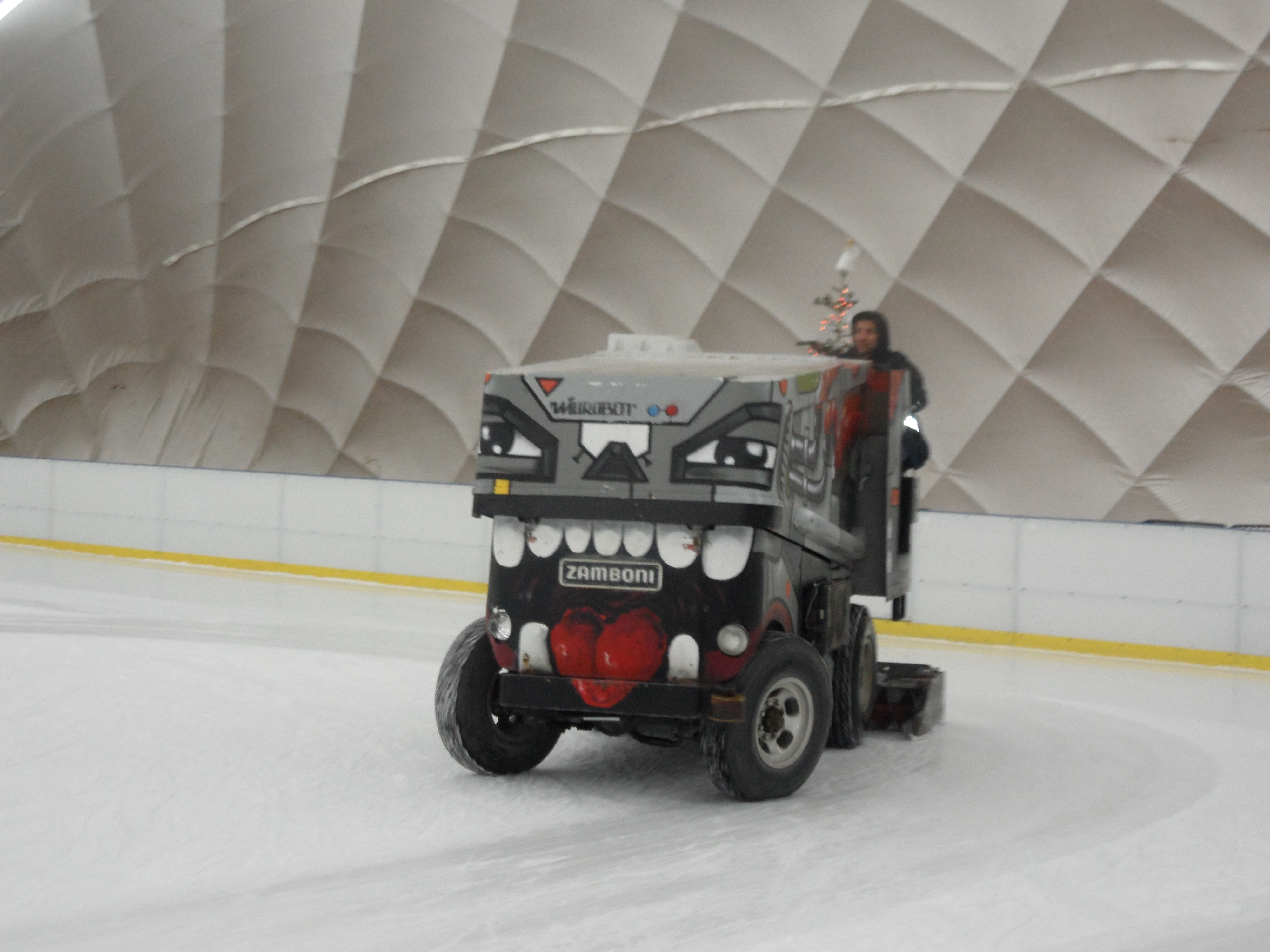|
Brașov Olympic Ice Rink
The Brașov Olympic Ice Rink ( ro, Patinoarul Olimpic Brașov) is a multi-purpose ice rink in Brașov, Romania. Located at number 5 Turnului Street which is 5 minutes walking distance from the railway station and easily accessible by public transportation, it was opened in January 2010. Construction The construction of the rink began on 16 May 2008. The proposed location was the Sports Park (then Tractorul Park), 730 metres north-west, in the place of a disused artificial pond. The rink was inaugurated on the 18 January 2010, with the goal of hosting competitions at the 2013 European Youth Olympic Winter Festival. The ice rink was first tested on 18 February 2010 by Tanja Szewczenko and Norman Jeschke and officially later that day with an ice hockey game between Corona Brașov and Steaua Rangers. Technical details There are three general areas: * Areas for sportsmen: ** Special access for sportsmen, referees and officials ** 6 locker rooms with 25 places each ** Locker room ... [...More Info...] [...Related Items...] OR: [Wikipedia] [Google] [Baidu] |
Steaua Rangers
Steaua Rangers Are a Romanian ice hockey team that currently plays in the Romanian Hockey League. They play their home games at Mihai Flamaropol. History The hockey team was founded in 1951 as CCA București and existed alongside other sections (e.g., football, handball, basketball) in the Steaua București sports club. In 1961, their name was changed to CSA Steaua București. With 40 championship titles and 31 cup victories, Steaua is the most successful ice hockey team in Romania. They last won the Championship in 2006, and the Cup in 2008. In 2008, Steaua joined the MOL Liga along with CS Progym Gheorgheni in addition to the Romanian Hockey League. They finished in sixth place out of ten participants. Steaua did not return to the league in 2009-10, due to financial issues. The team plays in the 2022/23 season. Achievements *Campionatul Național: **Winners (40): 1953, 1955, 1956, 1958, 1959, 1961, 1962, 1964, 1965, 1966, 1967, 1969, 1970, 1974, 1975, 1977, 1978, 1980, 1982, ... [...More Info...] [...Related Items...] OR: [Wikipedia] [Google] [Baidu] |
Buildings And Structures In Brașov
A building, or edifice, is an enclosed structure with a roof and walls standing more or less permanently in one place, such as a house or factory (although there's also portable buildings). Buildings come in a variety of sizes, shapes, and functions, and have been adapted throughout history for a wide number of factors, from building materials available, to weather conditions, land prices, ground conditions, specific uses, prestige, and aesthetic reasons. To better understand the term ''building'' compare the list of nonbuilding structures. Buildings serve several societal needs – primarily as shelter from weather, security, living space, privacy, to store belongings, and to comfortably live and work. A building as a shelter represents a physical division of the human habitat (a place of comfort and safety) and the ''outside'' (a place that at times may be harsh and harmful). Ever since the first cave paintings, buildings have also become objects or canvasses of much artisti ... [...More Info...] [...Related Items...] OR: [Wikipedia] [Google] [Baidu] |
Resurfice Corporation
Resurfice Corporation is a manufacturer of ice resurfacing equipment based in Elmira, Ontario, Canada. Their Olympia brand product line includes push models through full size models built on a Chevy Powertrain. In early 2009, Don Schlupp, the company's director of sales and marketing, said that the company had about a 70% share of the market in North America, but later that year the company said it produces about the same number of machines as Zamboni. The company was selected as the official supplier of ice resurfacing equipment to the 2010 Winter Olympics in Vancouver in a lease of 17 machines. This also included a contract to develop battery powered machines resulting in the development of the Olympia Cellect. The Cellect is powered by NiCad batteries, recharges fully in 6–8 hours to provide 30-35 resurfacings before recharging. A pair of Olympia Cellect resurfacers failed while working the ice at the speed skating venue during the olympics forcing organizers to quickl ... [...More Info...] [...Related Items...] OR: [Wikipedia] [Google] [Baidu] |
Ice Resurfacer
An ice resurfacer is a vehicle or hand-pushed device used to clean and smooth the surface of a sheet of ice, usually in an ice rink. The first ice resurfacer was developed by American inventor and engineer Frank Zamboni in 1949 in the city of Paramount, California. As such, an ice resurfacer is often referred to as a "Zamboni" as a genericized trademark. History The first ice resurfacer was invented by Frank Zamboni, who was originally in the refrigeration business. Zamboni created a plant for making ice blocks that could be used in refrigeration applications. As the demand for ice blocks waned with the spread of compressor-based refrigeration, he looked for another way to capitalize on his expertise with ice production. In 1939, Zamboni built the Iceland Skating Rink in Paramount, California. In order to resurface the skating rink, 3 or 4 workers had to scrape, wash, and squeegee the ice. A thin layer of water was then added for the fresh ice. This process was extremely ... [...More Info...] [...Related Items...] OR: [Wikipedia] [Google] [Baidu] |
Ice Hockey
Ice hockey (or simply hockey) is a team sport played on ice skates, usually on an Ice rink, ice skating rink with Ice hockey rink, lines and markings specific to the sport. It belongs to a family of sports called hockey. In ice hockey, two opposing teams use ice hockey sticks to control, advance and Shot (ice hockey), shoot a closed, vulcanized, rubber disc called a "hockey puck, puck" into the other team's goal. Each goal is worth one point. The team which scores the most Goal (ice hockey), goals is declared the winner. In a formal game, each team has six Ice skating, skaters on the ice at a time, barring any penalties, one of whom is the goaltender. Ice hockey is a contact sport#Grades, full contact sport. Ice hockey is one of the sports featured in the Winter Olympics while its premiere international amateur competition, the Ice Hockey World Championships, IIHF World Championships, are governed by the International Ice Hockey Federation (IIHF) for both men's and women's co ... [...More Info...] [...Related Items...] OR: [Wikipedia] [Google] [Baidu] |
Figure Skating
Figure skating is a sport in which individuals, pairs, or groups perform on figure skates on ice. It was the first winter sport to be included in the Olympic Games, when contested at the Figure skating at the 1908 Summer Olympics, 1908 Olympics in London. The Olympic disciplines are Single skating, men's singles, women's singles, pair skating, and ice dance; the four individual disciplines are also combined into a team event, first included in the Winter Olympics in 2014 Winter Olympics, 2014. The non-Olympic disciplines include synchronized skating, Ice theatre, Theater on Ice, and four skating. From intermediate through senior-level competition, skaters generally perform two programs (the Short program (figure skating), short program and the Free skating, free skate), which, depending on the discipline, may include figure skating spins, spins, figure skating jumps, jumps, moves in the field, Figure skating lifts, lifts, Figure skating jumps#Throw jumps, throw jumps, death spira ... [...More Info...] [...Related Items...] OR: [Wikipedia] [Google] [Baidu] |
Celsius
The degree Celsius is the unit of temperature on the Celsius scale (originally known as the centigrade scale outside Sweden), one of two temperature scales used in the International System of Units (SI), the other being the Kelvin scale. The degree Celsius (symbol: °C) can refer to a specific temperature on the Celsius scale or a unit to indicate a difference or range between two temperatures. It is named after the Swedish astronomer Anders Celsius (1701–1744), who developed a similar temperature scale in 1742. Before being renamed in 1948 to honour Anders Celsius, the unit was called ''centigrade'', from the Latin ''centum'', which means 100, and ''gradus'', which means steps. Most major countries use this scale; the other major scale, Fahrenheit, is still used in the United States, some island territories, and Liberia. The Kelvin scale is of use in the sciences, with representing absolute zero. Since 1743 the Celsius scale has been based on 0 °C for the freezing ... [...More Info...] [...Related Items...] OR: [Wikipedia] [Google] [Baidu] |
Ice Resurfacer
An ice resurfacer is a vehicle or hand-pushed device used to clean and smooth the surface of a sheet of ice, usually in an ice rink. The first ice resurfacer was developed by American inventor and engineer Frank Zamboni in 1949 in the city of Paramount, California. As such, an ice resurfacer is often referred to as a "Zamboni" as a genericized trademark. History The first ice resurfacer was invented by Frank Zamboni, who was originally in the refrigeration business. Zamboni created a plant for making ice blocks that could be used in refrigeration applications. As the demand for ice blocks waned with the spread of compressor-based refrigeration, he looked for another way to capitalize on his expertise with ice production. In 1939, Zamboni built the Iceland Skating Rink in Paramount, California. In order to resurface the skating rink, 3 or 4 workers had to scrape, wash, and squeegee the ice. A thin layer of water was then added for the fresh ice. This process was extremely ... [...More Info...] [...Related Items...] OR: [Wikipedia] [Google] [Baidu] |
Norman Jeschke
Norman Jeschke (born 2 March 1979 in East Berlin, East Germany) is a German pair skater. Career Jeschke began skating at the age of three and was permitted to join the specially promoted sports club SC Dynamo Berlin. He first skated as a single skater, but later switched to pair skating. With partner Christine Tiltmann, he is the 1997 German junior national champion. After that partnership, he teamed up with Mariana Kautz. They placed 14th at the 2002 Winter Olympics. Their partnership ended following the 2002 World Championships. In May 2002, Jeschke teamed up with Danish figure skater Mikkeline Kierkgaard. They won the bronze medal at the 2004 German Championships. They were unable to compete internationally that season due to International Skating Union rules regarding country changes. They missed the 2004–2005 season because of injuries. After several injuries to Mikkeline Kierkgaard, they ended their partnership. Norman Jeschke worked for the Bundeswehr until Novembe ... [...More Info...] [...Related Items...] OR: [Wikipedia] [Google] [Baidu] |
Brașov
Brașov (, , ; german: Kronstadt; hu, Brassó; la, Corona; Transylvanian Saxon: ''Kruhnen'') is a city in Transylvania, Romania and the administrative centre of Brașov County. According to the latest Romanian census ( 2011), Brașov has a population of 253,200 making it the 7th most populous city in Romania. The metropolitan area is home to 382,896 residents. Brașov is located in the central part of the country, about north of Bucharest and from the Black Sea. It is surrounded by the Southern Carpathians and is part of the historical region of Transylvania. Historically, the city was the center of the Burzenland, once dominated by the Transylvanian Saxons, and a significant commercial hub on the trade roads between Austria (then Archduchy of Austria, within the Habsburg monarchy, and subsequently Austrian Empire) and Turkey (then Ottoman Empire). It is also where the national anthem of Romania was first sung. Names Brassovia, Brassó, Brașov, etc. According to Drago ... [...More Info...] [...Related Items...] OR: [Wikipedia] [Google] [Baidu] |
Tanja Szewczenko
Tanja Szewczenko (born 26 July 1977) is a German former figure skater and occasional actress. She is the 1994 World bronze medalist, 1997 Champions Series Final silver medalist, 1998 European bronze medalist, and 1993 World Junior bronze medalist. Personal life Szewczenko was born to Vera Küke, an ethnic German immigrant from the Soviet Union, and a Ukrainian father who left the family when she was two years old. Competitive career Szewczenko won the bronze medal at the 1993 World Junior Championships. In 1993, at the age of 16, Szewczenko won her first international competition at the Nations Cup in Germany, defeating the reigning world champion Oksana Baiul. A few weeks later, she won her first national title, defeating former Olympic champion Katarina Witt. Szewczenko competed at the 1994 Winter Olympics in Lillehammer, Norway. During a practice session before the long program, she collided with Oksana Baiul, sustaining a bruised right hip and abdomen. She fi ... [...More Info...] [...Related Items...] OR: [Wikipedia] [Google] [Baidu] |









.jpg)